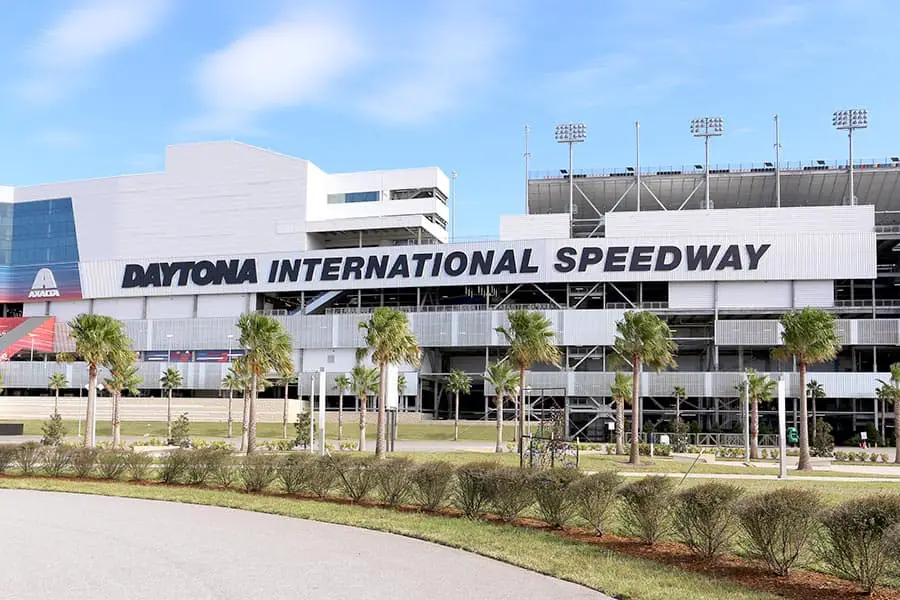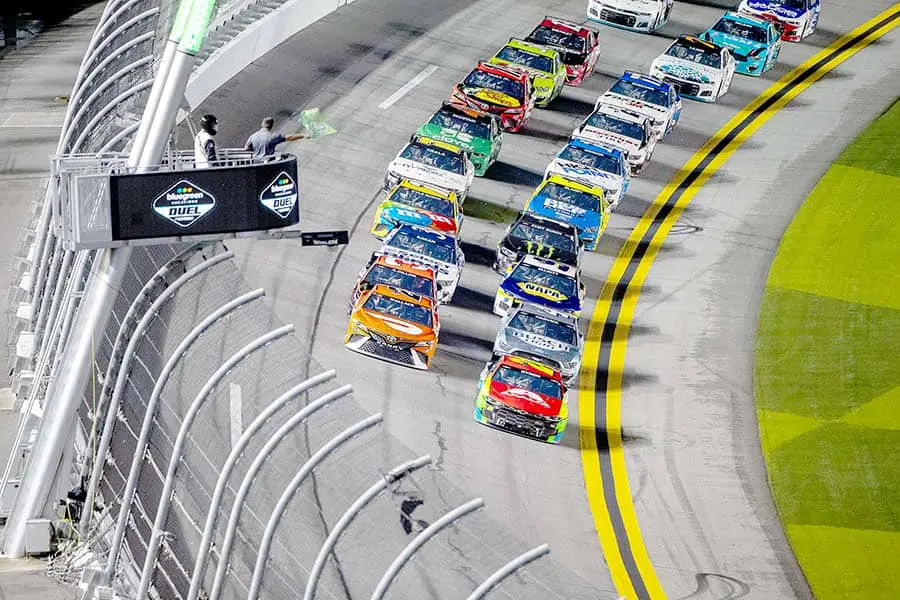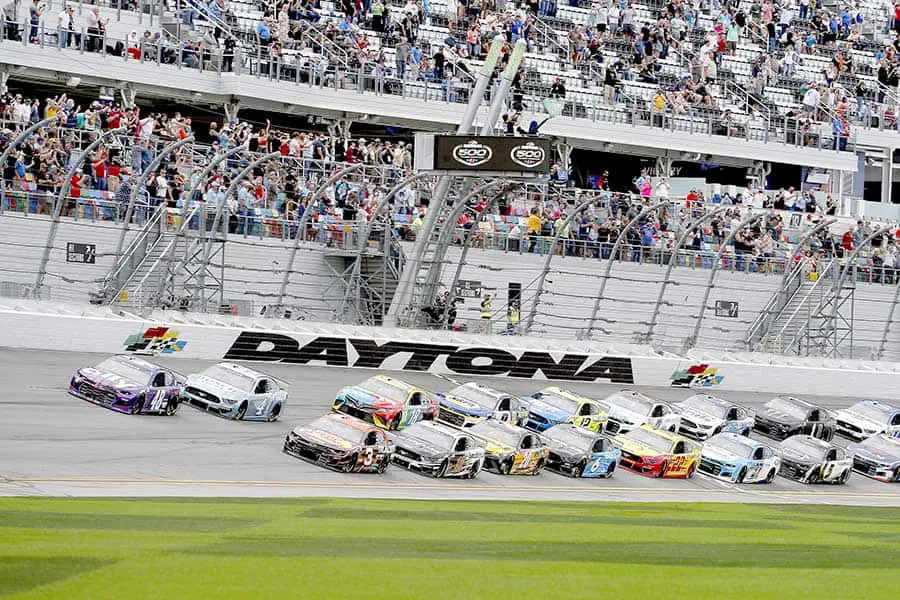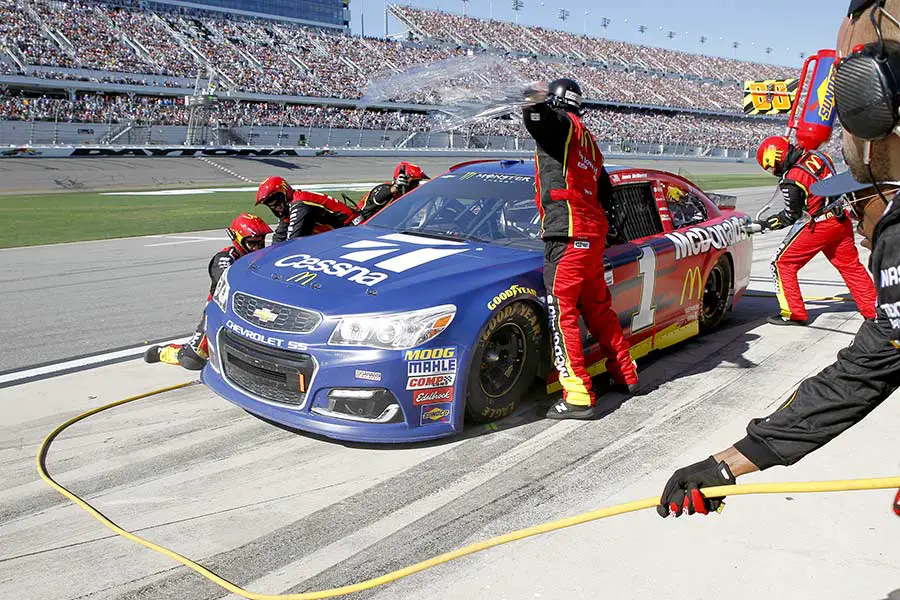
Known among race fans as one of the best tracks in the states, people from all over flock to the Daytona International Speedway to watch race-car drivers exercise their skills on this famous circle of pavement. But what kind of pavement is the speedway? Is Daytona asphalt or concrete?
Daytona International Speedway is paved with asphalt. While traditional asphalt pavement has some weaknesses that would be bad news for a racetrack, the construction of the Speedway’s pavement used special materials and techniques to keep it strong.
Why would they pave Daytona with asphalt instead of concrete? Since concrete is more durable, wouldn’t it be a better choice for a racetrack? Also, how much did it cost to pave Daytona in the beginning? In this post, you will learn the answers to these questions and more.
Daytona – Hard Surface, Hard Driving
When choosing a hard surface for driving, there are two leading contenders: asphalt and concrete. Asphalt is a material made from a petroleum product called bitumen and various filler materials. Modern pavement often uses eco-friendly recycled or repurposed materials. Old asphalt can even be recycled into new asphalt.
Asphalt roadways and tracks can be broken down into layers. The topmost surface is known, appropriately enough, as the surface layer. The surface is the part of the asphalt that cars drive on. Therefore, it must be durable and resistant to cracking and rutting. The specific mix of materials used in a surface layer varies from pavement to pavement, depending on the purpose of the road.
The next layer of asphalt is the binder layer. This layer of pavement binds the surface layer with the base course of pavement, effectively adhering the pavement together. The base course is the layer of pavement that connects the asphalt to the earth below — think of it as the foundation of a house.
Asphalt is a common paving surface because it is safe, durable, and flexible. It has slightly more give than surfaces like concrete, which helps keep the road from cracking. It is also much less expensive than concrete. However, asphalt can be vulnerable to certain types of water damage and delamination.
Phenomenal Florida Fun Fact: In 1987, driver Bill Elliot — known as Million-Dollar Bill —set a speed record when he completed a lap in 42.78 seconds, making his speed a whopping 210.36 miles per hour!
Cement, water, sand, and aggregate materials like gravel or crushed stone are combined together to form concrete. Cement is the binding material that hardens and sticks the concrete mix together. When used in the manufacture of roadways, concrete makes for a durable paving material. In addition, it is less prone to potholes, rutting, cracking, and stripping, which makes it a relatively low-maintenance road surface.
Surfaces paved with concrete often enjoy long spans of time without needing maintenance. For example, many concrete roads can go 40 or more years without needing to be resurfaced. This long time period is because concrete, essentially a rock, does not soften in the heat, which is of vital interest in sunny Florida. On the other hand, concrete is impossible to repair without completely jackhammering it apart, so it is a major chore to fix it if it does crack or become damaged.

Based on these factors, Daytona International Speedway is paved with asphalt. Racetracks, which are often on a steep incline and turning in relatively tight circles, are very challenging to pave. They are also subject to intense loads and forces that normal highways don’t experience.
A conventional road is built to withstand heavy vertical loads, as semi-trucks and regular cars are more or less compressing the pavement straight down. However, on a racetrack, there is more side-loading, so the engineers who design the tracks use different techniques to build them.
First, the asphalt itself is made with different materials. The pavement at Daytona contains a special polymer called “styrene-butadiene-styrene.” When added to asphalt, this polymer raises the flexibility of the asphalt while improving the aging resistance—helping it withstand the hot Florida sun as well as the thermal stress from racing tires zooming across them at 140 miles an hour.
Racetracks, and especially the track in Daytona, have to withstand rain hitting the sides of the pavement. Typically, this could cause water damage and delamination of the pavement. So the engineers who make tracks such as the one at Daytona use special techniques on the edges of the pavement that keep it watertight to prevent this kind of damage.
Not only is the paving itself different – the equipment needed to build it is, too. Because racetracks are built on steep angles, the pavers and other machines need to be specially modified so as not to skid down the track or lay different thicknesses of asphalt.
Not only that, but the pavement itself — blended as it was with a special kind of polymer — needed to be laid out at higher temperatures than usual to cure correctly. The need for a higher temperature required the construction crews to build a giant, mobile asphalt plant that could produce fresh, piping hot asphalt that would create the proper kind of surface for modern-day auto racing.

Other Posts of Interest
- Which Florida Coast Is Better for Fishing? And The Species You Can Catch
- What Is Sun’ n Fun? (Plus Tips For Attending)
- Are There Deer In Florida?
- Do Rockets Still Launch From Cape Canaveral?
How Much Did it Cost to Build Daytona Speedway?
Daytona International Speedway was originally built in 1959 by William France Sr., the founder of NASCAR. The racecourse was built to host races that were previously held at the Daytona Beach Road Course, which started on pavement before crossing over sandy beach and then transitioning back to pavement. The project cost about $600,000 in 1959 dollars, which translates to about 5.5 million dollars in today’s money.
In 2010, the speedway experienced an unexpected pothole that caused significant delays in the Daytona 500. While the pavement was initially repaired using Bondo, it was later completely resurfaced at the cost of about $20 million. The resurfacing was followed by renovations to the stands and facilities of Daytona at the expense of about $400 million.
Does NASCAR own Daytona Speedway?
NASCAR does own Daytona International Speedway. For much of its life, the Daytona International Speedway has been owned by International Speedway Corp., a motorsports promotion company that focused on buying and operating race tracks. However, in 2019, NASCAR decided to take back many of its historical racetracks and simply purchased International Speedway Corp.
Not only did this purchase enable NASCAR to regain ownership of many famous tracks, but it also enabled NASCAR to set its own schedule. Operating under International Speedway Corp. rules, NASCAR was required to book a certain number of events annually. Now that they own many more tracks, NASCAR enjoys a certain freedom of scheduling, which will likely be better for drivers, crews, and fans.
How Steep is the Track at Daytona?
Racing fans know that the track at Daytona has several steep turns and banks. In the turns, Daytona International Speedway banks at 31 degrees. On the tri-oval, the bank is 18 degrees. On the longer stretches of the track, the bank is designed to be close to zero, with just enough slope built in to aid in drainage.
How Many Pit Stalls Does Daytona Have?

A pit stall is a mechanical bay in which a race car driver will have their car serviced during the race. During a pit stop, several things may happen, such as refueling, tire changes, mechanical corrections, and necessary repairs are done. The art of the pit stop is an impressive event to see.
Daytona International Speedway has 82 pit stalls. Usually, not all of the stalls are used: races commonly have about 40 cars in them. The pit stalls can be configured for the different needs of racing teams.
What is the Difference Between a Raceway and a Speedway?
Is a speedway the same thing as a raceway, or is there some subtle difference between these two things? Generally speaking, there is little difference between a raceway and a speedway. The terms are interchangeable.
That said, many race tracks choose their term carefully. Internet wags have pointed out that some names work better with “raceway” versus “speedway” because of the abbreviations. For example, “Phoenix Motor Speedway” would abbreviate to “PMS,” which could cause unwanted jokes or other distractions when marketing races and events.
The names also have subtle differences in connotation. For example, a raceway seems focused on the race itself, so a more technical track might want to name itself accordingly. On the other hand, tracks focused on building up high speeds might find that speedway is a better description for their track.
The Final Lap
Daytona International Speedway is a phenomenal racetrack. With classic lines, banks, and turns designed by the founding father of NASCAR himself, Daytona holds a special place in every racing fan’s heart. The track continues to host some of auto racing’s most well-known events.
The track itself has been rebuilt several times, but the most current surface on Daytona is built to last, made of asphalt mixed with special polymers. In addition, it was constructed using the most advanced modern equipment available. As a result, the asphalt racetrack at Daytona International Speedway will be hosting races for generations to come.





